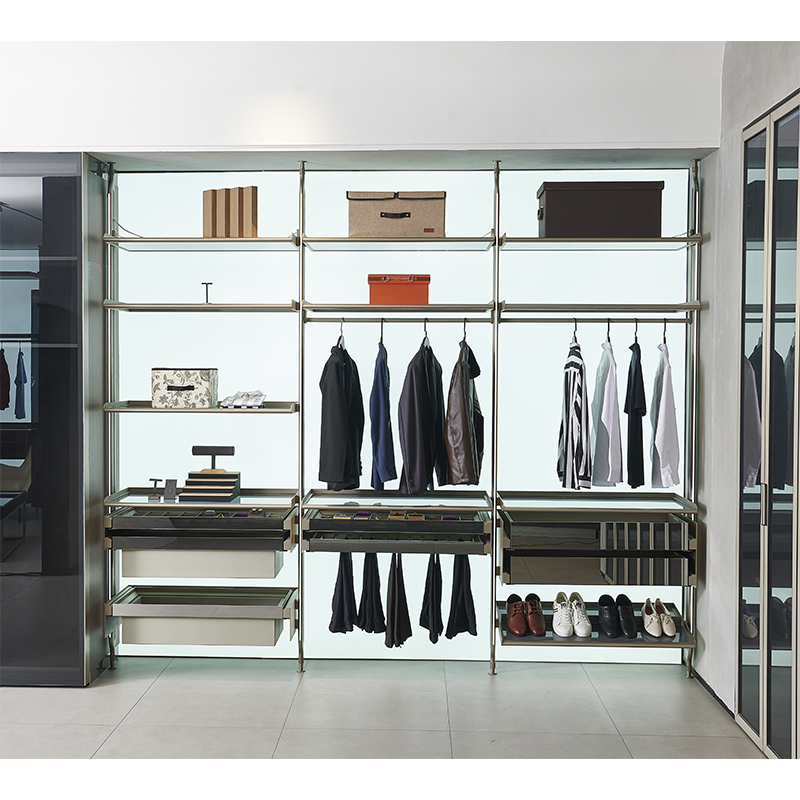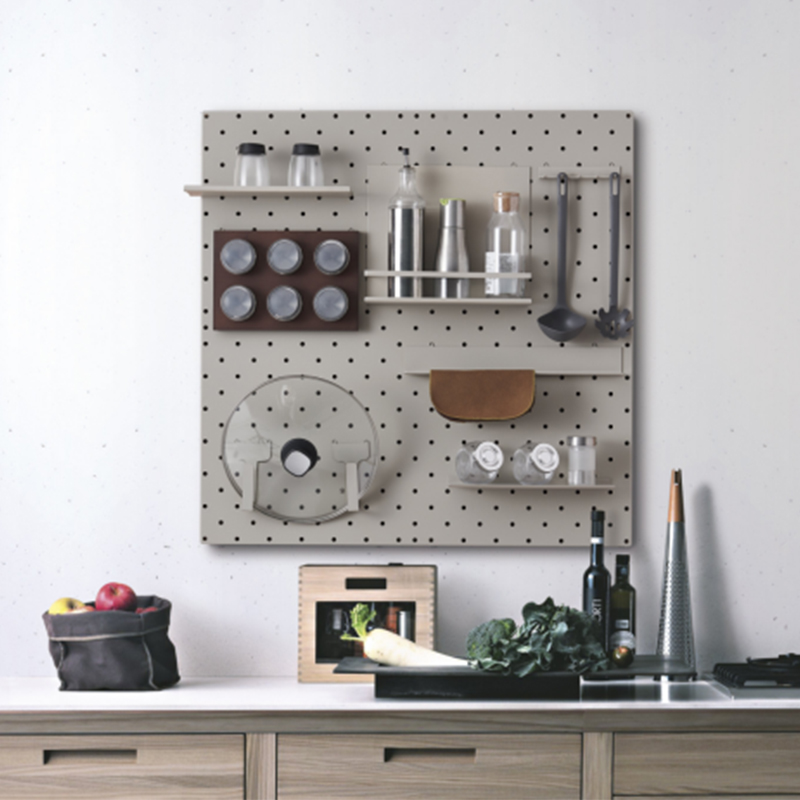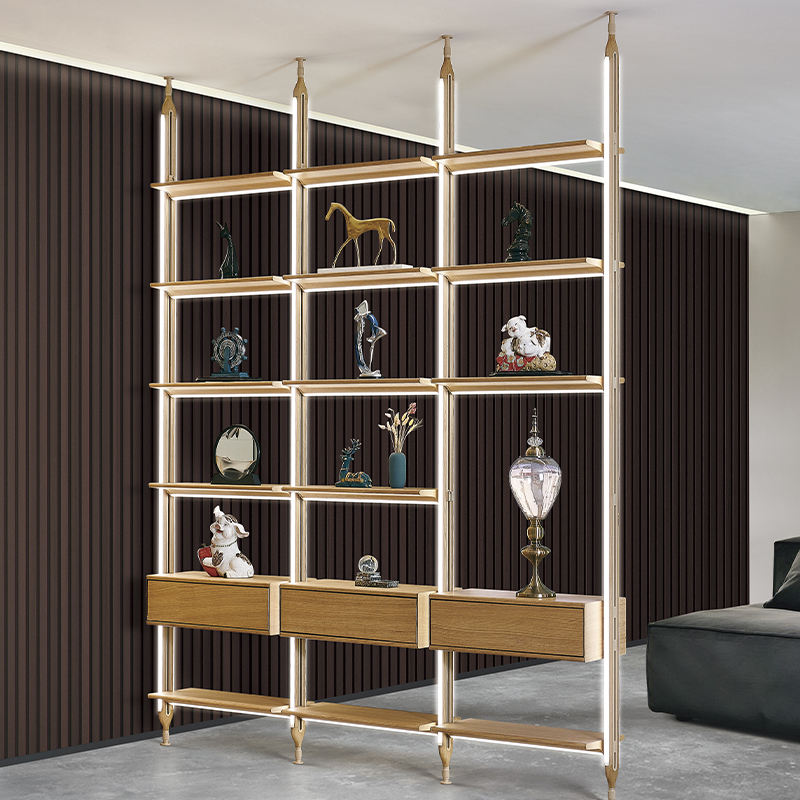How does pegboard surface treatment affect its durability?
Release Time : 2025-08-13
As a crucial component of kitchen hardware, pegboard's surface treatment directly impacts its durability, aesthetics, and ease of maintenance. Various surface treatment techniques can significantly enhance pegboard's corrosion resistance, wear resistance, and overall lifespan. Understanding these treatments and their impact on durability helps users choose the product that best suits their needs and ensures long-term, reliable use.
One common surface treatment is electroplating. Electroplating deposits a layer of metal, such as chromium or nickel, onto the pegboard surface, creating a protective layer. This treatment not only enhances its appearance but also strengthens its corrosion resistance. The electroplated layer effectively isolates moisture and oxygen from the air, preventing oxidation and rusting. Furthermore, the electroplated layer's high hardness makes it resistant to scratches and wear from daily use, keeping the pegboard looking new for a long time. In kitchen environments, which are prone to moisture and oil, electroplated pegboard is more resistant to humid and greasy working conditions, reducing the need for cleaning and maintenance.
Another widely used surface treatment is powder coating. This process applies a powder coating evenly to the pegboard surface and then cures it at high temperatures to form a hard, continuous coating. Powder coating not only offers a wide range of colors to suit various decorative styles, but also significantly improves weather and UV resistance. Powder-coated pegboard resists fading or aging outdoors or in direct sunlight. The coating also exhibits excellent flexibility and adhesion, resisting peeling even with minor impacts or bending, extending the product's lifespan.
Hot-dip galvanizing is also a common surface treatment. This process involves immersing the pegboard in molten zinc, which chemically reacts with the substrate to form a durable zinc alloy layer. Hot-dip galvanizing provides pegboard with exceptional corrosion resistance, making it particularly suitable for use in high-humidity or corrosive environments. The zinc alloy layer not only resists moisture but also self-heals minor scratches and damage, further enhancing its protective properties. Despite its relatively high initial cost, hot-dip galvanizing's exceptional durability makes it an ideal choice for many professional kitchen and industrial applications.
Anodizing is commonly used on aluminum pegboard. Electrolysis creates an oxide film on the aluminum surface, offering excellent wear resistance and a variety of color options. The anodized film's microporous structure allows for dyeing to impart a unique appearance to the pegboard. More importantly, this treatment significantly improves the aluminum's corrosion resistance and hardness, allowing it to withstand harsh conditions for extended use without losing its luster. For modern kitchens that prioritize design and functionality, anodized pegboard offers both aesthetic appeal and long-lasting performance.
In addition to the major surface treatments mentioned above, specialized techniques include PVD (physical vapor deposition) and nano-ceramic coating. PVD coating utilizes a vacuum-based physical process to deposit an ultra-thin, extremely hard film of a metal compound onto the pegboard surface. This coating not only offers exceptional wear and corrosion resistance, but also possesses excellent optical properties, resulting in a metallic luster and texture. Nano-ceramic coating utilizes advanced nanotechnology to create a dense, protective ceramic layer on the pegboard surface. This coating combines high hardness with excellent flexibility, remaining stable under extreme conditions and providing excellent protection.
It's important to note that regardless of the surface treatment used, proper installation and ongoing maintenance are equally important. For example, avoiding hard objects from hitting or scratching the surface during installation can prevent damage to the coating. Regular cleaning with mild detergents, rather than strong acids or bases, helps maintain the finish. Proper maintenance not only extends the lifespan of pegboard but also preserves its aesthetics and functionality.
In short, the surface treatment of pegboard has a profound impact on its durability. From electroplating and powder coating to hot-dip galvanizing, anodizing, and even more advanced PVD coatings and nano-ceramic coatings, each treatment offers an optimized solution for specific applications. By understanding the characteristics and advantages of these processes, users can choose the most suitable pegboard product for their needs, ensuring optimal performance in a variety of environments and adding both practical value and aesthetic appeal to their kitchen spaces. With advances in materials science and technological developments, more innovative surface treatments will emerge in the future, further enhancing the durability and versatility of pegboard and other hardware products.
One common surface treatment is electroplating. Electroplating deposits a layer of metal, such as chromium or nickel, onto the pegboard surface, creating a protective layer. This treatment not only enhances its appearance but also strengthens its corrosion resistance. The electroplated layer effectively isolates moisture and oxygen from the air, preventing oxidation and rusting. Furthermore, the electroplated layer's high hardness makes it resistant to scratches and wear from daily use, keeping the pegboard looking new for a long time. In kitchen environments, which are prone to moisture and oil, electroplated pegboard is more resistant to humid and greasy working conditions, reducing the need for cleaning and maintenance.
Another widely used surface treatment is powder coating. This process applies a powder coating evenly to the pegboard surface and then cures it at high temperatures to form a hard, continuous coating. Powder coating not only offers a wide range of colors to suit various decorative styles, but also significantly improves weather and UV resistance. Powder-coated pegboard resists fading or aging outdoors or in direct sunlight. The coating also exhibits excellent flexibility and adhesion, resisting peeling even with minor impacts or bending, extending the product's lifespan.
Hot-dip galvanizing is also a common surface treatment. This process involves immersing the pegboard in molten zinc, which chemically reacts with the substrate to form a durable zinc alloy layer. Hot-dip galvanizing provides pegboard with exceptional corrosion resistance, making it particularly suitable for use in high-humidity or corrosive environments. The zinc alloy layer not only resists moisture but also self-heals minor scratches and damage, further enhancing its protective properties. Despite its relatively high initial cost, hot-dip galvanizing's exceptional durability makes it an ideal choice for many professional kitchen and industrial applications.
Anodizing is commonly used on aluminum pegboard. Electrolysis creates an oxide film on the aluminum surface, offering excellent wear resistance and a variety of color options. The anodized film's microporous structure allows for dyeing to impart a unique appearance to the pegboard. More importantly, this treatment significantly improves the aluminum's corrosion resistance and hardness, allowing it to withstand harsh conditions for extended use without losing its luster. For modern kitchens that prioritize design and functionality, anodized pegboard offers both aesthetic appeal and long-lasting performance.
In addition to the major surface treatments mentioned above, specialized techniques include PVD (physical vapor deposition) and nano-ceramic coating. PVD coating utilizes a vacuum-based physical process to deposit an ultra-thin, extremely hard film of a metal compound onto the pegboard surface. This coating not only offers exceptional wear and corrosion resistance, but also possesses excellent optical properties, resulting in a metallic luster and texture. Nano-ceramic coating utilizes advanced nanotechnology to create a dense, protective ceramic layer on the pegboard surface. This coating combines high hardness with excellent flexibility, remaining stable under extreme conditions and providing excellent protection.
It's important to note that regardless of the surface treatment used, proper installation and ongoing maintenance are equally important. For example, avoiding hard objects from hitting or scratching the surface during installation can prevent damage to the coating. Regular cleaning with mild detergents, rather than strong acids or bases, helps maintain the finish. Proper maintenance not only extends the lifespan of pegboard but also preserves its aesthetics and functionality.
In short, the surface treatment of pegboard has a profound impact on its durability. From electroplating and powder coating to hot-dip galvanizing, anodizing, and even more advanced PVD coatings and nano-ceramic coatings, each treatment offers an optimized solution for specific applications. By understanding the characteristics and advantages of these processes, users can choose the most suitable pegboard product for their needs, ensuring optimal performance in a variety of environments and adding both practical value and aesthetic appeal to their kitchen spaces. With advances in materials science and technological developments, more innovative surface treatments will emerge in the future, further enhancing the durability and versatility of pegboard and other hardware products.








